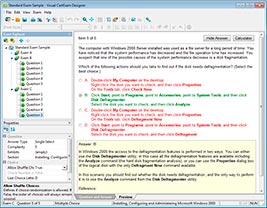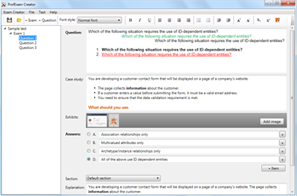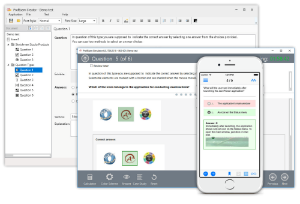Download Implementing Cisco Service Provider Advanced Routing Solutions (SPRI).300-510.ExamTopics.2025-05-28.107q.vcex
| Vendor: | Cisco |
| Exam Code: | 300-510 |
| Exam Name: | Implementing Cisco Service Provider Advanced Routing Solutions (SPRI) |
| Date: | May 28, 2025 |
| File Size: | 11 MB |
How to open VCEX files?
Files with VCEX extension can be opened by ProfExam Simulator.
Discount: 20%
Demo Questions
Question 1

Refer to the exhibit. Which tree does multicast traffic follow?
- shared tree
- MDT default
- source tree
- MDT voice
Correct answer: B
Question 2

Refer to the exhibit. The green policy is designed with low delay, and the pink policy is designed with low cost. What is the next hop for node A on its way to node D, with the objective of achieving a low delay?
- 192.168.1.2
- 192.168.3.2
- 192.168.3.6
- 192.168.1.6
Correct answer: A
Question 3
Refer to the exhibit.

An engineer is troubleshooting IS-IS configuration between two areas. IS-IS Area-A network 30.1.1.0/24 is leaked into IS-IS Area-В. R2 is failing to filter the route updates from network 10.1.1.0/24. Which configuration must the engineer apply to resolve the issue?
- R2(config)# ip prefix-list List2 seq 5 deny 10.1.1.0/24R2(config)# interface fastethernet 0/0R2(config-if)# ip router isis 100R2(config-if)# router isis 100 -R2(config-router)# distribute-list gateway List2 in
- R2(config)# ip prefix-list List1 seq 3 deny 10.1.1.0/24R2(config)# ip prefix-list List1 seq 5 permit 30.1.1.0/24 ge 25 1eR2(config)# ip prefix-list List1 seq 10 permit 0.0.0.0/le 32R2(config)# interface fastethernet 0/0R2(config-if)# ip router isis 122R2(config-if)# router isis 122 -R2(config-router)# distribute-list prefix List1 in
- R1(config)# ip prefix-list List2 seq 5 deny 10.1.1.0/24R1(config)# interface fastethernet 0/0R1(config-if)# ip router isis 100R1(config-if)# router isis 100 -R1(config-router)# distribute-list gateway List2 inR (config-if)# router isis 150 -R1(config-router)# distribute-list route-map Map1 in
- R2(config)# access-list 101 deny ip any 10.1.1.0 0.0.0.127R2(config)# access-list 101 permit ip any 30.1.1.0 0.0.0.63R2(config)# access-list 101 deny ip any 0.0.0.0 0.0.0.0R2(config)# interface fastethernet 0/0R2(config-if)# ip router isis 121R2(config-if)# router isis 121 -R2(config-router)# distribute-list 101 in
Correct answer: A
Question 4
Refer to the exhibit.

CE1 and CE2 are iBGP neighbors in AS 65516. All traffic that exits AS 65516 must use the link from CE1 to PE1. CE1 is advertising a higher local preference to CE2, but traffic from CE2 still prefers the PE2 link. Which action corrects the problem?
- Add the lower local-preference value on PE2 towards CE2.
- Configure CE1 to send routes to CE2 with a higher MED.
- Configure CE1 to send routes to CE2 with a higher weight.
- Add the next-hop self command to the CE1 neighbor statement for CE2.
Correct answer: D
Question 5
Refer to the exhibit.

Routers R1 and R2 reside in AS 65530, which is multihomed to the Internet. A network engineer expects devices in the AS to use R2 to access the Internet, but they are using R1 as the exit point from the AS. Which action corrects the problem?
- Add a sequence number to the route map to remove the implicit deny.
- Change the route map direction in the neighbor statement to out.
- Configure the route map with a local preference of 200 or higher.
- Remove the neighbor statements from the address family configuration and activate the neighbor globally on R1.
Correct answer: B
Question 6

Refer to the exhibit. What is the relationship between Router 1 and Router 2?
- Router 1 centrally learns the topology of the network to aid in SR-TE path selection, and Router 2 is a node that feeds Router 1 topology information
- Router 1 and Router 2 are participating in SR-TE tunnels and are both head-end routers
- Router 1 and Router 2 centrally learn the topology of the network to aid in SR-TE path selection for peers
- Router 2 is the head-end router in an SR-TE tunnel, and it is learning topology of the network from the PCE enabled on Router 1
Correct answer: A
Question 7
An engineer is working to implement segment routing protocol on the customer’s core network. Which step should the engineer take before the segment routing is enabled and is running with BGP?
- Segment routing must be configured with EIGRP
- Segment routing must be configured with ISIS
- MPLS must be configured
- Explicit-null must be configured for all neighbors
Correct answer: C
Question 8

Refer to the exhibit. Traffic flow from router R1 to router R6 is delay-sensitive. It must consider potential link-failure and node-failure conditions. Which configuration must an engineer apply to router R1 to route traffic to router R6 if router R2 fails?
Correct answer: C
Question 9

Refer to the exhibits. A network operator is troubleshooting packet loss seen from the R1 loopback interface to the R2 loopback interface over the core network. The operator is attempting to identify the next leg in the path from PE1. Which interface and label path should the operator investigate next?
- PE1 – Gi0/0/0/2 – forwarding label 24001
- PE1 – Gi0/0/0/3 – forwarding label 24002
- PE1 – Gi0/0/0/2 – forwarding label 24002
- PE1 – Gi0/0/0/3 – forwarding label 24001
Correct answer: B
Question 10
Refer to the exhibit.

An MPLS core network has connectivity issues R4 has failed. It impacts traffic loss between R1 and R8. Customers report no access to their file servers, which delays their transformation work. Which quick action resolves the issue until R4 recovers?
- Implement Link and Node protection on routers R2 and R7.
- Disable traffic engineering so that traffic prefers the IGP path
- Enable MPLS ТЕ fast reroute on router R1 and Link and Node protection on router R2.
- Configure IBGP full mesh for faster convergence.
Correct answer: B
Question 11
Refer to the exhibit.

An engineer is troubleshooting connectivity issues on the MPLS core network. A customer connected through R4 cannot reach the OSPF domain on R5. While checking the routing table of R1, the engineer cannot see all the routes from R3 and R5. Which task must the engineer perform so that R4 is able to reach R5?
- Enable OSPF peering and configure route redistribution between routers R4 and R1.
- Enable route filtering between routers R1 and R3.
- Enable MP-BGP peering on routers R1, R3, R4, and R5.
- Enable OSPF on the Area-0 routers and configure MP-BGP between routers R1 and R3.
Correct answer: A
HOW TO OPEN VCE FILES
Use VCE Exam Simulator to open VCE files

HOW TO OPEN VCEX AND EXAM FILES
Use ProfExam Simulator to open VCEX and EXAM files


ProfExam at a 20% markdown
You have the opportunity to purchase ProfExam at a 20% reduced price
Get Now!








